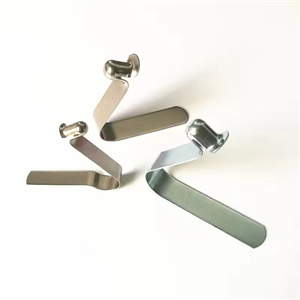Tempering Treatment of Snap Button Spring Clips
In the field of metal processing and heat treatment, tempering is an important process step mainly used to improve the mechanical properties of metal materials, such as toughness, ductility, and strength. Snap Button Spring Clips are made of steel and their usage environment and performance requirements require tempering treatment. Therefore, tempering treatment may be used to remove internal stress caused by stamping. Usually, a single tempering is used to heat the steel to an appropriate temperature (usually between 200-350 degrees Celsius) and maintain it for a certain period of time.
The specific temperature and time for tempering treatment need to be determined based on the material, size, purpose, and performance requirements of Snap Button Spring Clips. At the same time, before tempering treatment, it is necessary to clean the surface of the material to ensure the best tempering effect.
Tempering treatment may have a certain impact on the appearance and size of Snap Button Spring Clips, so strict control and testing are required during the manufacturing process.
The heat treatment of Snap Button Spring Clips is mainly for the following purposes:
Improved hardness and strength:
Heat treatment can change the microstructure of the material and increase its hardness and strength. This ensures that the spring clamp is not easily deformed during use, and is better able to withstand the pressure and frequent use during fastening. For example, in applications where clothing or bags are often pulled and rubbed, the robust spring clips retain their shape and function without loosening or damaging easily.
Improved toughness and fatigue resistance:
Appropriate heat treatment can improve the toughness of the material and reduce brittleness while increasing the hardness. This helps to prevent fracture or fatigue failure of the spring clip during repeated use. Take the four-button on a shoe as an example. People constantly apply force to the button during walking. The spring clip with good toughness and fatigue resistance after heat treatment can withstand this long-term dynamic load.
Optimize elastic properties:
Heat treatment can adjust the elastic characteristics of the spring clip, so as to make it have better resilience and lasting elasticity. For example, in some application scenarios requiring frequent opening and closing, such as the four-fold buckle on the folder or package, good elasticity ensures that each buckle is tight and reliable.
Enhanced corrosion resistance:
Some heat treatment processes can form a protective film on the material surface or change its chemical structure, thereby improving the corrosion resistance of the spring clip and extending its service life. Four-chspring clips used in wet or chemical environments are better protected against corrosion by proper heat treatment.
Removal of internal stress:
Internal stresses generated during manufacture may cause the spring clip to deform or crack in service. Heat treatment can effectively eliminate these internal stresses and improve the dimensional stability and reliability of the product.
